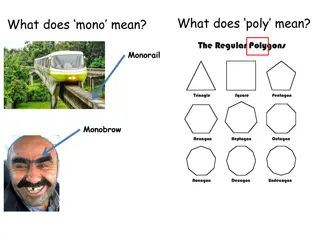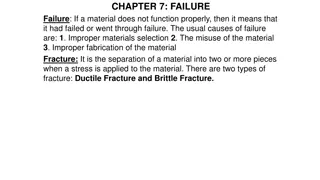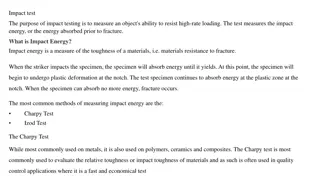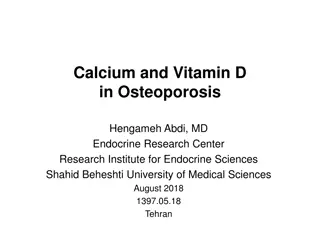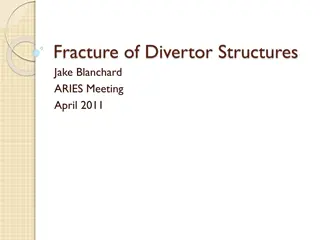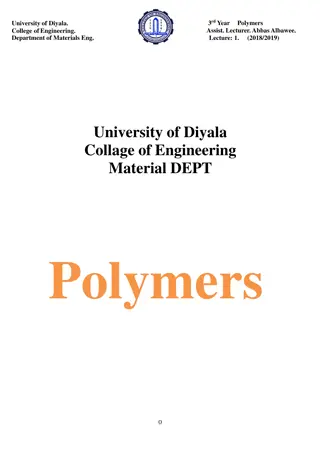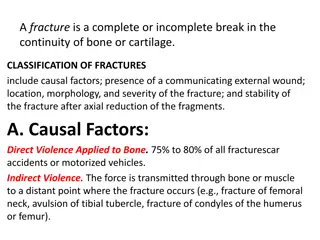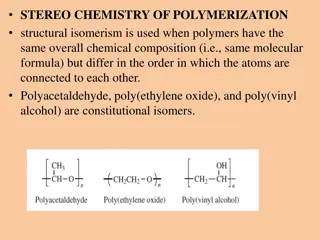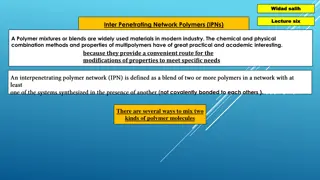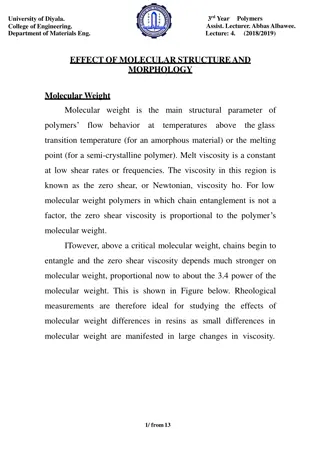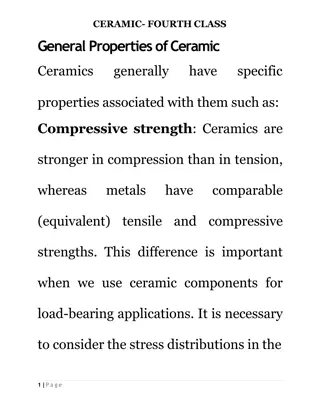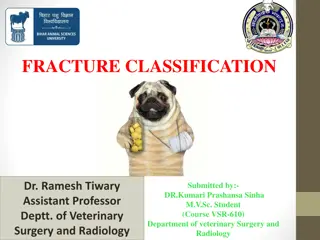Understanding Impact Behavior and Fracture Energy of Polymers
Polymers with high impact resistance are sought after for their ability to absorb energy before failure. Factors affecting impact behavior, such as molecular weight and orientation, are discussed. Methods for measuring impact strength and creep failure are explored, along with the advantages of blended materials. The critical fracture energy during fractures of rubber-like materials is examined using a trouser-tear test, providing insights into energy dissipation and deformation processes in polymers.
Download Presentation

Please find below an Image/Link to download the presentation.
The content on the website is provided AS IS for your information and personal use only. It may not be sold, licensed, or shared on other websites without obtaining consent from the author. Download presentation by click this link. If you encounter any issues during the download, it is possible that the publisher has removed the file from their server.
E N D
Presentation Transcript
3rdYear Assist. Lecturer. AbbasAlbawee. Lecture: 17. (2018/2019) Polymers University of Diyala. College of Engineering. Department of Materials Eng. Impact Behavior of Polymers Impact Fracture A good polymer is generally defined as one capable of absorbing a large amount of energy before failure. Poly carbonates have one of the highest impact resistance values. However, amorphous polymers exhibit brittle behaviour under impact, especially if the component is notched or is too thick relative to a corner radius. The occurrence of brittle failure can be decreased by: increasing the molecular weight, inclusion of rubber phase, inducing orientation in the polymer and reducing internal defects and contaminants. Measuring impact strength Conventional Izod tests are used to measure the energy required to break a notched specimen, however, this is not considered as a satisfactory test. Major limitation being that most polymers as notch sensitive and fail readily under izod test. Creep Failure Taking into account the viscoelastic path at small strain based on thermally activated rate processes. When strain attains higher values, high enough to lead to failure, its slope versus time exhibits an abrupt change. At this specific time the creep function appears a minimum. In most cases DMTA (Dynamic mechanical 1/ from4
thermal analysis) can be used to determine the viscoelastic behavior of samples as a function of time. A classic case is when the rubber hose ruptures due to creep after many years of service. DMTA can be used for o-rings and gaskets to measure the creep rates. Blends Blended materials can have an increased fracture toughness with balanced stiffness and strength. Usually these are formed ftom copolymerization or modification with a suitable elastomer. However, the mechanical properties of blends, especially the modulus, follow the rule of mixture Voigt model and the morphologies show coarsed dispersion. Fracture Energy One technique commonly utilized to measure the critical fracture energy during fracture of rubber-like materials is a trouser-tear test. This method got its name becarrse the specimen for these tests consists of a rectangular sheet cut along its long axis to form a trouser-shaped sample (Figure 1). The legs of the trouser specimen are then pulled in opposite directions to create tearing action. Determination of critical fracture energy from other test methods requires accurate determination of crack length, whereas the critical energy release and rate of crack 2/ from4
propagation during a trouser-tear test are independent of crack length and sample geometry. The critical fracture energy from a tear test is also known as tearing energy, which is the energy spent per unit thickness per unit increase in crack length. Tearing energy includes surface energy, energy dissipated in plastic flow processes, and energy dissipated irreversibly in viscoelastic processes. The advantage of using the trouser-tear test lies in the assumption that all of these changes in energy are proportional to crack length and is primarily affected by the deformation in the vicinity of the crack- tip. Hence, the total energy is independent of the shape of the test specimen and the way the forces are applied. In other words, although the stress distribution at the tip of a tear crack is complex, it is independent of the crack length. 3/ from4
In mathematical terms, the work done during a tear test can be given by: where F is the tearing force and Ac is the tear distance [3]. It is important to note that the changes in extension of the material between the tip of the tear and the legs are negligible and were ignored in this equation. The tearing energy, or critical fracture energy, can be written as: where B is the thickness of the specimen. Hence, by combining Equations 1 and 2: It can be confirmed from Equation 3 that the critical tearing energy is independent of the initial sample geometry and crack length. The critical tearing energy could have also been calculated using Equation 2, although more complicated crack length 4/ from4
measurement before and after the tear test is needed to achieve good results. 5/ from4






